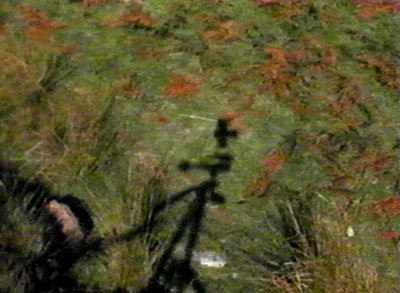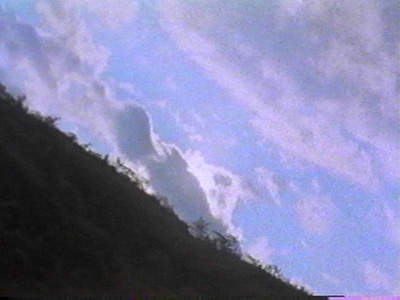

1974, 16 mm, colour, sound, 20 min.
"In the 20-minute 'Seven Days' (1974) Welsby finds his mature voice, offering a tour de force unlike anything cinema had yet seen. He took one frame of a Welsh landscape every ten seconds for a week, with the camera anchored to the same spot - though it did swivel. Placed on an equatorial mount (used in astronomy for photos of stars), it followed the sun across the sky. Moreover the camera flipped back and forth between two positions governed by the sun's visibility: when it was out, the camera turned 180 degrees from the sun (and the frame includes the camera's shadow moving across the land), and when the sun was behind clouds, it pointed straight at the sun.
"What might sound like a gentle observational film seems to me quite violent. The wind roars on the sound track; clouds streak by almost apocalyptically; the camera flips back and forth for no obvious reason. On close observation, though, one can usually anticipate these changes by noticing a hint of sun behind the clouds or the land darkening: it's possible to see the natural "cause" of each cut in the preceding shot. This is a film that rejects the long tradition of landscape painting (and much subsequent landscape filmmaking) in which images serve as metaphors for the artist's emotions. Instead viewers are invited to bring their own responses to this enjambment of nature and the machine.
"The camera's movement in 'Seven Days' reveals a tiny stream, a group of flowers, some distant ridges. This is not a landscaped garden but a random assemblage of natural objects with an unordered beauty, a beauty the viewer must discover. (Welsby counts John Cage as another influence.) The film's rough edges and jittery, speeded-up rhythms seem calculated to express both the protean side of nature (the changing weather is apparent not only in clouds but in raindrops on the Plexiglas Welsby placed in front of the lens to protect it) and the violent, mechanical motion of the mechanized tripod. Just as sailing involves learning to work with the tides and the wind, the mechanisms of filmmaking can be brought into sync with nature's forces. Ethics and aesthetics come together here, as Welsby suggests that filmmakers let the clouds do a little editing."
Fred Camper
Chicago Reader, April 13, 2001
